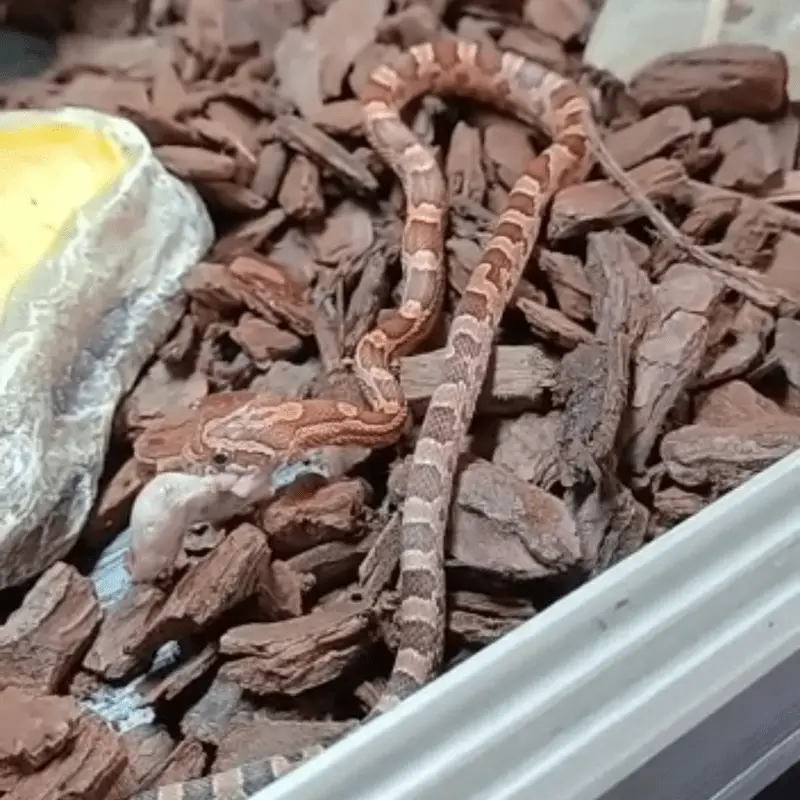Snakes are known for their quirky eating habits. Not only do they gobble up their prey whole, but sometimes snakes can even eat down astonishingly sized animals that are bigger than themselves. That raises a simple question, can a snake die from eating prey too big.
Yes, that can happen. Even though dying from swallowing a prey too big to handle is not that common, it sometimes happens. In most cases, the snake will regurgitate the prey if it is too big. A healthy snake will not have any difficulty in spitting the prey out. However, if the snake is not able to spit it out, it may die.
Can snakes struggle to eat?
If the prey of the snake is too large, it will not be able to swallow it. Even Though captive snakes do not get the opportunity to try and eat big prey, sometimes the owners can make a mistake and offer them a large rodent, which they cannot handle. In such cases, the snake will regurgitate the prey, or it could die.
Eating Prey The Wrong Way Round
Most of the time, snakes consume their prey in a head-first approach. Thanks to their unique body structures, most snakes prefer to eat animals with a long and narrow body shape. While a snake can extend their jaw significantly, they are not that comfortable eating the prey that is too wide. Eating the prey the wrong way round will always create a problem for them that they will need to resolve.
Recommended Read
The snakes have a unique feeding reflex. When it hunts, that instinct gets triggered. The problem is, it may have bitten the prey at the wrong angle. While the snakes can make these adjustments independently, sometimes they make mistakes, leading to problems during feeding.
If your pet snake has had prey stuck in its mouth, and it’s been a few days. Had unsuccessful attempts to adjust the prey or regurgitate, then you will need to contact a veterinarian.
What do snakes eat?
Snakes are carnivorous. The diet of the snakes mostly depends on the species. On the one hand, you can find snakes that eat insects and amphibians, while on the other, you can find snakes that eat warm-blooded animals. Snakes that are kept in captivity eat animals like rats and mice.
As snakes eat their prey whole, it is easier for the owners to offer them a nutritionally rich diet. That is one reason why snakes do not suffer from dietary-related issues that you can witness in other captive bred reptiles.
Should I offer live prey to my snake?
It is not advisable to feed live animals to your pet snakes. Even small animals, like a mouse, can severely injure a snake. The captive snakes are accustomed to consuming dead animals. You can get freshly killed or frozen prey for your pet snake. You can also avoid the trauma that the prey goes through during the hunting process.
Feeding Size Recommendation
If you are feeding your pet snake, never give them anything more than 1.5 times bigger than the broadest part of its body. By offering them the right-sized prey, you can reduce the chances of such untoward incidents significantly.
Remember to thaw the frozen prey before offering it to your pet snake.
Can a snake choke on its prey?
Prey can get stuck inside the snake’s mouth, however, the snake can’t get choked by its prey. Snakes have a unique organ, named glottis, located inside their mouth right on the top of their windpipe. When the snake opens its mouth to swallow the prey, the glottis moves up against the nostril. This position of the glottis enables the snakes to breathe even when they are consuming their food.
If the prey gets stuck in the snake’s mouth and does not come out for several days, then the snake shouldn’t choke with the help of the glottis.
My snake isn’t swallowing their food straight away. What should I do?
Leave your snake alone with the prey for some time. Most beginner snake owners think that the prey goes down to the snake’s belly immediately, but that is not the case. It takes considerable time for the food to reach down to the oesophagus of the snake.
Most snakes, in such cases, will resolve the issue on their own. However, if you find that the prey gets stuck in the mouth of your snake and it’s been a few days, then you should not waste any more time. Get in touch with your veterinary professional immediately to dislodge the prey from the mouth of the snake.
How often do snakes need to feed?
Well, that mostly depends on the size, species of snake, size of their last meal, and activity level of your snake. Generally, predatory animals can spend a few days between meals.
However, a snake can survive on a meal nearly every day to even just one meal every few weeks. The younger snakes need to feed more often to keep on fueling their growth. Smaller snake species need to eat more often than the bigger ones.
Conclusion
If you are thinking of getting a pet snake, you need to understand all the different aspects of the feeding habits of the snake. You also need to understand the difference between vomiting and regurgitation among snakes. While the regurgitation can happen if the snake swallows too big of a prey, vomiting is a sign of illness. If your snake is vomiting their food, make sure to consult with the veterinary experts as soon as possible.

